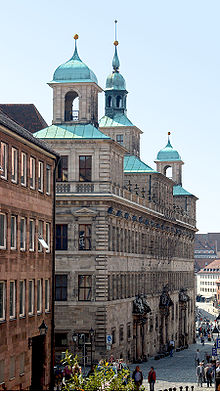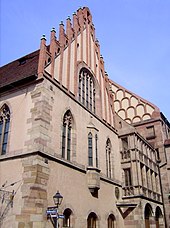City Hall (Nuremberg)
The Nuremberg town hall is located in the old town of Nuremberg , just east of the choir of the Sebalduskirche . As one of the city's sights, it is part of Nuremberg's Historical Mile . The imposing Renaissance building by the architect Jakob Wolff the Younger (1571–1620) was badly damaged during the Second World War and had to be largely rebuilt in the 1950s. The building was shortened by two window axes on the north side. On the south side, a core is Gothic hall building integrated, the Albrecht Dürer designed. The dungeon prisons in the basement are a tourist attraction, as is the Schöne Brunnen , which is located directly in front of the New Town Hall designed by Kurt Schneckendorf in 1951 and built between 1954 and 1956 . This building replaced the row of houses between the old town hall and the main market that was destroyed in the war .
Building history
Old Town Hall

Until the 14th century the city did not have its own town hall . Instead, the council met in a house of cloth makers , which is alternately referred to in documents as the “Gewandhaus”, just as the “House” or as the “The Citizens House”. Only when the Lorenzer and Sebald halves of the city were united to form the universitas civium and connected by a common wall did the council acquire a property from Heilsbronn Monastery in 1322 and later expanded the area to the north by buying houses and converting them for administrative purposes.

The hall building on the south side, which contains the large town hall hall on the upper floor , was the oldest part of the building complex from 1332-1340 under the direction of the city architect Philipp Groß . The hall building from the 14th century was followed by two annex buildings along the town hall courtyard to the north, of which the one with the council chamber on the east side was preserved.
At the beginning of the 16th century, the city council began an extensive renovation of the town hall. The so-called Ratsstubenbau with the late Gothic curtain wall was built by Hans Beheim the Elder between 1514 and 1515 in the north. The facade painting was carried out in 1521, the painting of the large hall according to drafts and under the direction of Albrecht Dürer began in 1521 and ended in 1528/30. It was the largest wall and ceiling painting in Europe at the time and was only surpassed by the Sistine Chapel , which was started ten years later .
With the self-confidence of a flourishing imperial city, the decision was made almost 100 years later to build a new building in the architecture of an Italian palace. After preliminary planning and conception by the city architect Wolf Jacob Stromer , planned by Jakob Wolff the Younger as a four-wing complex (therefore also called Wolff'scher Building ), the building in 1616–1622 did not turn out to be so Italian. Although the horizontal, which until then unknown in Nuremberg's history in the elongated monumental plays a dominant role, but with the absolutely unthinkable in Italy Zwerchhäusern reverses the roof region back to the local vertical.
The foundation stones were laid in 1616 and 1619. All Gothic building elements were sacrificed to him on the west side. The uniform window front contrasts with the three baroque portals, whose sculptures, including figures from the Bible book Daniel, were designed by the sculptor Leonhard Kern on behalf of the city council in 1617 . The coat of arms of the Holy Roman Empire of the German Nation with the imperial eagle is emblazoned above the central portal, the main entrance .
With the beginning of the Thirty Years' War, construction slowed down and came to a standstill in 1622. The main building in the west and three wings around the town hall courtyard were completed and furnished. The buildings were only completed after the end of the war. The facade still characterizes the town hall today.
The walls of the small town hall were decorated in 1825 as part of restoration measures by Christian Friedrich Fues with painted portraits of famous Nuremberg donors. The magistrate had this cycle replaced by history pictures by Friedrich Wanderer in 1889/90 .
In the north-east corner of the large town hall courtyard and on the south side of Theresienstraße, new buildings in neo-Gothic style were built from 1885–1889 according to plans by August Essenwein . At about the same time, Hans Pylipp built a new office building in place of the old five-man house on Fünferplatz. Heinrich Wallraff based his new buildings north of Theresienstrasse from 1907–1910 on the Nuremberg Renaissance of the 16th century. For this purpose, parts of the building of the former Dominican monastery were demolished.
In 1944/45, after bomb hits during the air raids on Nuremberg, the entire town hall complex burned down, except for the surrounding walls. It was not until 1956–1962 that the old town hall was rebuilt on this ruin under the direction of Harald Clauss. The inside of the old town hall hall was only restored between 1982 and 1985, including the wall cladding and the coffered wooden barrel ceiling. Because the photo documentation of the wall painting, which was once done by Albrecht Dürer's workshop based on his designs, was lost, the painter Michael Mathias Prechtl was commissioned with a design for a contemporary painting. After a long controversial and bitter discussion, Prechtl withdrew his design in 1988, the walls remained white, and local politicians decided to take a “pause for thought”. After a video installation in the summer of the Dürer anniversary year 2012, in which both an animation based on the recovered photo documentation from 1944 and the projection of the Prechtl design on the still white wall, a renewed discussion arose about the restoration of the painting .
new town hall
The buildings between the town hall and the northern end of the main market square were also destroyed during the Second World War. In 1951, the architect Kurt Schneckendorf planned the so-called New Town Hall (also Schneckendorf-Bau ) in its place , which was built from 1954 to 1956. The New Town Hall is designed in the style of the 1950s with a grid facade . Sandstone was used for the pilaster strips to match the historical cityscape . The alignment of the new building deviates from a right angle inward and reveals the view of the south tower of the old town hall.
Trivia
Until 2013, replicas of the imperial crown , imperial scepter and imperial orb of the Holy Roman Empire of the German Nation were exhibited in an adjoining room of the hall of honor . They were then exhibited at the Imperial Castle . From autumn 2016 they will form the focus of the permanent exhibition in the Fembohaus city museum . The original imperial regalia were once intended for permanent safekeeping in Nuremberg and have been in Vienna since 1800 .
Among the sculptures enthroned on the three baroque portals, which were created by the sculptor Leonhard Kern in 1617 , there are also figures that are modeled on the animals mentioned in the prophecies in the 7th chapter of the book of Daniel in the Old Testament of the Bible , where they are used for various World powers in history stand: on the portal to the left of the main entrance the lion with eagle wings ( Dan 7.4 EÜ ) and the bear ( Dan 7.5 EÜ ), on the portal to the right of the main entrance the leopard with four bird wings and four heads ( Dan 7.6 EÜ ) as well as the mysterious beast with the ten horns ( Dan 7.7 EÜ ).
Individual evidence
- ↑ Nürnberger Nachrichten: "Imperial regalia can be seen in the castle for one year"
- ↑ Time travel for those in a hurry: Krone. Power. Rich. ( Memento of the original from April 10, 2016 in the Internet Archive ) Info: The archive link was inserted automatically and has not yet been checked. Please check the original and archive link according to the instructions and then remove this notice. on the homepage of the city museum
literature
- W. Barth: The Nuremberg town hall building by Jakob Wolff d. J. , Erlangen, 1986 (Master's thesis).
- Christian Brick: Reconstruction and repainting of the old Nuremberg town hall. A documentation. Berlin, 1991. (Download 85.2 MB)
- Harald Clauß, Julius Lincke: The old town hall and the large town hall hall since they were destroyed in the war
- I. Harald Clauß: The restoration of the shell in 1956/1958 and the installation of the restaurant in 1962
- II. Julius Lincke: Planning and measures to restore the interior in 1977 . In: Nürnberger Altstadtberichte , Ed .: Altstadtfreunde Nürnberg eV, Issue 5 (1980).
- Matthias Mende: Town Hall . In: Michael Diefenbacher , Rudolf Endres (Hrsg.): Stadtlexikon Nürnberg . 2nd, improved edition. W. Tümmels Verlag, Nuremberg 2000, ISBN 3-921590-69-8 ( online ).
- Isabelle Guyot: L'empreinte luthérienne dans les hôtels de ville du Saint-Empire de la paix d'Augsbourg à la fin de la guerre de Trente ans: Lunebourg, Nuremberg, Augsbourg , Université Lumière, Lyon 2, 2006 (Master's thesis)
- K. Matthäus: On the history of the Nuremberg calendar system. The development of the annual calendar printed in Nuremberg. In: Buchform, special edition from the archive for the history of the book industry. Volume 9: Delivery 3–5, Nuremberg. Nuremberg State Archives, Nuremberg 1968, pp. 966–1395.
- Matthias Mende: The old Nuremberg town hall. Building history and equipment of the large hall and the council chamber. Nuremberg 1979 (= Nuremberg City History Museums. Volume 15).
- Matthias Mende (ed.): Albrecht Dürer - an artist in his city , Nuremberg 2000; passim also for the town hall renewal under Albrecht Dürer (especially p. 216 ff.).
- E. Mummenhoff (Ed.): "Studies on the topography and history of the Nuremberg town halls", Collectif, communication from the Association for the History of the City of Nuremberg, Fifth Issue, Nuremberg, Im Selbstverlag des Verein, 1884, 240 p., P. 137– 214.
- E. Mummenhoff, H. Wallraff: The town hall in Nuremberg, Nuremberg , Schrag, 1891, 365 pp.
- KH Schreyl (ed.): Emblema Politica. The symbols in the Nuremberg town hall , Nuremberg, Verlag Hans Carl and Stadtgeschichtliche Museen Nürnberg, 1980, 96 pp.
See also
Web links
- The old town hall on Rathausplatz - photo collection
- New Town Hall (Nuremberg) at FrankenWiki
- Alexander Racz: Nuremberg's historic town hall hall - citizens' decision 2014: http://kunstnuernberg.de/der-historische-rathaussaal-nuernberg/
Coordinates: 49 ° 27 '18.7 " N , 11 ° 4' 39.2" E







